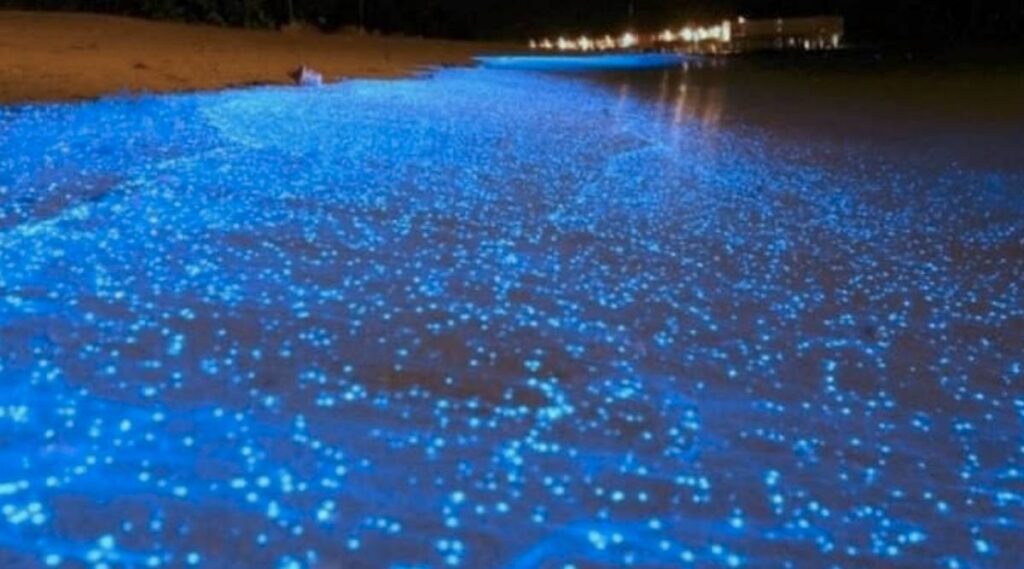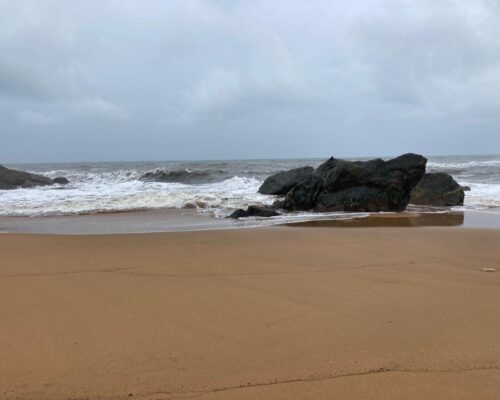Phytoplankton, which is also known as microalgae, are similar to terrestrial plants in that they contain chlorophyll and require sunlight in order to live and grow. Most phytoplankton is buoyant and floats in the upper parts of the ocean, where sunlight penetrates the water. Phytoplankton also requires inorganic nutrients such as nitrates, phosphates, and sulfur which they convert into proteins, fats, and carbohydrates respectively.
The two main classes of phytoplankton are dinoflagellates and diatoms respectively. Dinoflagellates use a whip-like tail, or flagella, to move through the water and their bodies are covered with complex shell-like structures. Diatoms also have shells, but they are made of a different substance and their structure is rigid and made of different interlocking parts. Diatoms do not rely on flagella to move through the water in the ocean and instead rely on ocean currents to travel through the water.
In a balanced ecosystem, phytoplankton provides food for a wide range of sea creatures including shrimps, snails, and jellyfish. When too many nutrients are available, phytoplankton may grow out of control and form harmful algal blooms which are also known as HABs. These blooms can produce extremely toxic compounds that have harmful effects on fish, shellfish, mammals, birds, and even people who consume contaminated seafood. Our resort in Gokarna is close to a beach where you can spot several phytoplanktons if you are lucky.
Our resort in Gokarna is one of the best resorts for you to relax and rejuvenate yourself in between your visits to the beach to spot phytoplanktons.
Examples of Phytoplanktons –
Coccolithophorids – Coccolithophorids is an extremely important species of phytoplankton that exhibit characteristic calcium carbonate plates known as coccoliths. Although this type of phytoplankton is a really important microfossil, it is also a source of dimethyl sulfide, which is thought to represent a potential mechanism by which to regulate climate change. It is thought that by increasing the number of this phytoplankton, the enhanced level of dimethyl sulfide will become oxidized, forming sulfur dioxide and sulfate aerosols respectively. These aerosols will function as cloud seed nuclei that will increase cloud coverage and the reflection of sunlight in the water.

Image Credits: Towno
Cyanobacteria – Cyanobacteria are extremely small phytoplankton that typically inhabits less turbulent waters and can thrive in environments where there are extremely few nutrients available. Cyanobacterial species are highly diverse and have been shown to be extremely tolerant to changes in aquatic conditions, thus outcompeting many other types of phytoplankton when water temperatures change or nutrients become less abundant and scarce.
Diatoms – Diatoms are extremely important phytoplankton that while microscopic, replicate extremely rapidly. Diatoms can be used as an indication of water quality, as they follow a “bloom-and-bust” life cycle pattern. As nutrients reach the sunlight surfaces of an ocean, diatoms rapidly reproduce and grow. When the nutrients are depleted such as silicon, this growth ceases. Diatoms also comprise a substantial portion of the organic matter found in the sediment of large bodies of water respectively.
Dinoflagellates – Dinoflagellates are important phytoplankton typically involved in supporting coral reef ecosystems as a significant food source for many species in particular. Dinoflagellates are known to cause harmful algae blooms exhibiting a characteristic red color, termed “red tide” which is extremely dangerous. Such blooms have been known to contaminate shellfish, which will cause food poisoning in humans if consumed and can be fatal too.
What does Phytoplankton eat?
Phytoplankton is primarily dependent on minerals found in aquatic environments and Vitamin B to survive. For aquatic environments to support phytoplankton, the presence of iron, phosphate, silicic acid, and nitrate is very much required. Indeed, when there is a deficiency in these macronutrients, there is a corresponding absence of phytoplankton in the ocean waters.
Phytoplankton and Ozone Depletion –
Phytoplankton and zooplankton, which are microscopic marine organisms that play crucial roles in complex ecological food webs, are very sensitive to UV radiation. Because UV-B radiation is absorbed by only a few layers of cells, large organisms are more protected, whilst smaller ones, such as unicellular organisms in aquatic ecosystems, are among the most severely affected by harmful UV radiation. Depletion of the ozone layer could have drastic effects on plankton and other small marine organisms at the base of the ocean food chain respectively. These creatures are highly sensitive to UV radiation because they lack any protective outer layers. The increase in UV radiation threatens the growth and survival of the tiny creatures that provide the original food source for the rest of the ocean food chain and is essential for the ocean to thrive.
How plastics and human waste is affecting plankton –
It may not exactly be breaking news that we’re trashing our oceans with loads and loads of plastic. But scientists are still making new discoveries around how this is impacting marine life and especially plankton including phytoplanktons. Recently, scientists observed some species of zooplankton actually eating plastic which is absolutely harmful to them! This discovery is really bad news for not just plankton, but the massive amount of life they also support in the ocean. Microplastics are tiny pieces of plastics that have broken upland which resemble the food of zooplankton and thus become enticing to a hungry little crustacean.
And why is it bad for the building blocks of all other ocean life to be ingesting plastic of all things? In short, plastics introduce a variety of toxic chemicals into their host which is deadly for them. Whether these be chemicals stemming directly from the plastic composition itself such as BPA, or a toxin that is attached to the plastic while it spent time floating in a marine environment such as DDT, anything that eats plastic stands to be impacted by the toxins. This is not good for any ocean life.
Bioluminescent Planktons –
So what is the phenomenon of bioluminescence? It is simply a phenomenon by which an organism has the ability to emit light from its very own body. Many organisms use it to attract mates, while some, like our plankton, use it as a defense to scare away potential predators in the waters. In quite a few species of life, however, there is no specific reason for their distinct glow. Scientists have ascertained that it might simply be a byproduct of their evolutionary cycle.
So where and how do you see these beautiful magnificent microorganisms? Gokarna, as it turns out, is one of the prime spots in India to see the beautiful bioluminescent phytoplankton. Nighttime is the only time you can see them, and it is advised to travel during the new moon as moonlight might hamper sighting them.
And if you want a completely exclusive, our resort in Gokarna which is the Red Earth Gokarna is a beautiful, sustainable beach resort Gokarna located at the edge of Honey Beach, a pristine, secluded beach where you can watch the miracle of bioluminescence in India.



